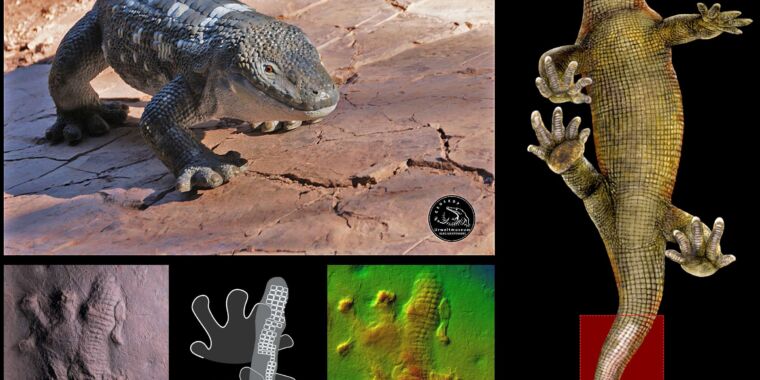Voigt et. al./Urweltmuseum GEOSKOP.
Their feet left copious traces in muddy Permian floodplains, leaving tracks scattered across ancient sediments. But in one slab of such trackways, scientists uncovered something more: the trace of an animal’s tail as it dragged across the ground. Strikingly, these tail prints come complete with scale impressions—at 300 million years old, they’re among the earliest scale impressions we have.
This may seem small, but it shows us that some of the hardened skin structures necessary for our ancestors to survive on land had evolved much earlier than previously suspected. A paper published in Biology Letters this past May describes this discovery in detail.
A rare find
The particular slab holding these traces was discovered in 2020 at the Piaskowiec Czerwony quarry in Poland. Mining had stopped to enable paleontologists to search the red sandstone rocks for fossils. Gabriela Calábková described climbing upon “a huge pile of rubble” only to discover a sizable slab of fossil tracks at the very top. There, among one set of footprints, was something new.
She called to her colleagues to join her at the top of the pile. None of them, she said, had ever encountered that kind of trace fossil before, but they “quickly understood that it must be a body impression,” she explained to Ars.
Calábková is a paleontologist at the Moravian Museum. She and her co-authors are part of a joint effort by Polish, Czech, and German scientists studying the Permian in Poland—a geologic time period that stretches from 289.9 to 252 million years ago. The Piaskowiec Czerwony quarry is the world’s second-largest producer of one particularly recognizable type of Permian track known as Ichniotherium cottae. (If you were asked to draw hands, you might come up with something that looks like Ichniotherium cottae. The five bulbous imprints of the digits are almost cartoonish.)
Footprints and tail drags are examples of ichnofossils, or trace fossils. As their name suggests, these are the fossilized marks or traces made during the life of an animal. Matching the exact animal to its trace is almost impossible, especially when body fossils are absent, so traces themselves are often given scientific names.
In this case, however, we may have identified the source, which is why the world’s leading site of these same tracks is in nearby Germany, where the spectacular Bromacker site has not only produced abundant Permian tracks, it has also provided the fossils of animals with feet that appear to match the prints. They belong to diadectimorphs, four-legged vertebrates (tetrapods) that were a distant forerunner of mammals.
Bromacker has also provided a helpful verification of the exceedingly rare tail drag found in the Piaskowiec Czerwony quarry. The only two other known tail drags associated with I. cottae trackways were found there. They, too, have similar corn cob-shaped scales.

Daisy Hips is a science communicator who brings the wonders of the natural world to readers. Her articles explore breakthroughs in various scientific disciplines, from space exploration to environmental conservation. Daisy is also an advocate for science education and enjoys stargazing in her spare time.








